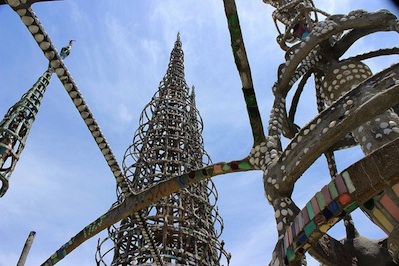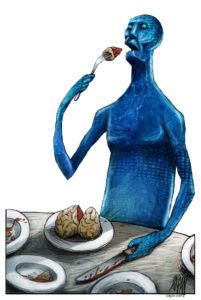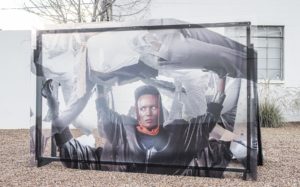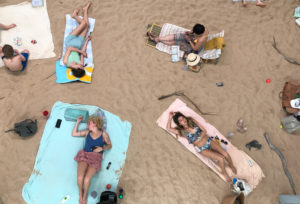The Watts Towers
A new book celebrates Sabato Rodia's towers in Watts, a massive sculptural lifework of a whimsical eccentric, made from found objects and without power tools or scaffolding. The Watts Towers in Watts, Los Angeles. Photo by IsabelleAcatauassu (CC BY 2.0)
The Watts Towers in Watts, Los Angeles. Photo by IsabelleAcatauassu (CC BY 2.0)
|
To see long excerpts from “Sabato Rodia’s Towers in Watts” at Google Books, click here. |
“Sabato Rodia’s Towers in Watts: Art, Migrations, Development” A book edited by Luisa Del Giudice
I first saw Sabato (Simon) Rodia’s majestic towers when I was a young civil rights worker in Watts in 1964. Between organizing and demonstrations, I wandered over to the towers several times, mesmerized by their rich detail, vibrant color and overall imagination. In subsequent years, especially after moving to Los Angeles in 1979, I have returned to the Watts Towers frequently, often as a tour guide for my UCLA students.
They share my pleasure in seeing Rodia’s fantastic city consisting of several interconnected towers, a gazebo and a boat, constructed of junk sculpture and mosaic tiling, wrapped in wire mesh, a remarkable feat of both art and engineering. They see, with wonder and awe, what Rodia called “Nuestro Pueblo” (Our Town in Spanish). They also understand that one trip alone to the Towers is hardly adequate. Many subsequent visits are necessary to see and appreciate the stunning way that Rodia used found objects such as soda bottles, ceramic tiles, shells, pieces of glass and other fragments that he embedded in concrete throughout the work.
Despite these gratifying field trips, I have been disheartened that so few of my students have ever seen this iconic work by one of the most creative and eccentric artists of the 20th century. Most of them have lived in Southern California their entire lives and have usually heard of the Watts Towers. But they share the typical bias of white (and other) people in Los Angeles: Watts is a dangerous, off-limits area and should be avoided at all costs. Nevertheless, after many educational trips to the Towers and the adjacent Watts Towers Arts Center, I can happily report that no one has been robbed, assaulted or otherwise harmed, and that many students have been exposed to one of the most magnificent works of public art in the world.
Still, a distressing lack of knowledge about both Rodia and his magnificent creation remains the norm in Southern California and elsewhere. That has the potential to change with the recent publication of “Sabato Rodia’s Towers in Watts.” Scholar Luisa Del Giudice has assembled an extensive collection of articles and essays that detail everything about Rodia and his work. The book covers, among many other themes, the Towers’ cultural and art historical context and legacy, their contested and controversial status as a public site in Los Angeles, and their future in a city still struggling with massive economic problems where preservation of a quirky historical landmark may not necessarily be a major political priority for many resident taxpayers.
Several of the volume’s essays have specific appeal to specialized scholars. For them, this book is simply indispensible; Del Giudice has done remarkable work in compiling diverse works of scholarship from multiple sources. It is likely that “Sabato Rodia’s Towers in Watts” will be the definitive academic reference on the topic for decades to come.
It is useful, for example, to understand the significance of Rodia’s Italian heritage and how his life and work fit into the broader pattern of Italian migration and identity. Del Giudice herself and several of her fellow scholars reinvigorate a vision of Italian and Italian American history and culture. This theme has been neglected even in an age of multiculturalism, when Asian-American, Latino and African-American visions have largely dominated educational, journalistic and public discourse.
Likewise, it is fruitful to locate the Watts Towers in a broad art historical perspective. This volume situates Rodia’s monumental work in a broader tradition of “folk” or “vernacular” art. It contains intriguing material, for example, about Antoni Gaudi’s visionary works in Catalonia, Francisco Gonzalez Gragera’s and Justo Gallego Martinez’s constructions in Spain, and Litto Damonte’s Hubcap Ranch in California’s Napa Valley, among many others.
Sociologists, anthropologists, political scientists, city planners and other urban specialists may also take special interest in the book’s section on the contested conservation, guardianship, racial and ethnic politics, and cultural heritage of the Watts Towers. Many of the readings detail the highly contentious struggles in Los Angeles for many decades around these issues; they are still far from fully resolved. An understanding of these problems and controversies go beyond the Towers and Los Angeles themselves. They have considerable relevance to many other cities in the United States and elsewhere grappling with ownership, community control, and preservation of large-scale public artworks.
Beyond its research utility for scholars and academics, this book has more general value for many lay readers. Several of the readings lead them to discover how Rodia actually implemented his fervent desire to “do something big” from 1921 to 1954. Even repeat visitors to the Watts Towers regularly wonder how one man managed to produce such a magnificent work. Sarah Schrank’s article, taken from an earlier source, provides some answers.Rodia, who called himself a “steel man,” had worked for a tile company and collected pieces of tile from homes throughout Los Angeles. He gathered the broken glass, shells and other objects from the neighborhood and the beach. He used steel rebar that he bent into shape by placing it under nearby railroad tracks and then bending it with his body. The shaped rebar was overlapped with heavy wire, wrapped with another layer of chicken wire. He created his own brand of cement to encase the entire wire-wrapped joint and pressed broken glass, tiles and other found objects into the mortar.
Rodia did all of this without power tools or scaffolding, using only ladders and pulleys to ease his movements during the construction — a truly remarkable one-man accomplishment. And then, his lifework completed, he gave away his property and left Watts, never seeing his towers again. He died in 1965 in Northern California, a month before the Watts Riots.
Of even greater interest to contemporary readers is the close linkage of the Watts Towers to the African-American community in today’s Los Angeles. Although the demography of Watts is changing from almost exclusively African-American to substantially Latino, in the public’s eye, Watts remains a black neighborhood. “Sabato Rodia’s Towers in Watts” provides an especially useful perspective on the close linkage of the Watts Towers and its surrounding black community.
A key component is the role of the Watts Towers Arts Center, which presently oversees the Towers as a constituent part of the Los Angeles Department of Cultural Affairs. Operating as a community arts center, it offers classes to young people, mounts exhibitions, often of African-American artists, and generally serves as a powerful and effective social institution in Watts. It provides low-cost informative tours of the Watts Towers conducted by extremely well-informed guides. Its longtime director, Rosie Lee Hooks, is passionately dedicated to the Towers and their preservation.
Many of the African-American visual artists who have been associated with the Watts Towers Arts Center have themselves been powerfully influenced by Rodia’s masterpiece. This volume details that story effectively. For example, it offers commentary by iconic artists Betye Saar, Judson Powell, John Outterbridge and Charles Dickson on their role as assemblage artists working with found objects in the Rodia tradition. It also focuses extensively on the pioneering efforts of Noah Purifoy, the first director of the Watts Towers Arts Center and the key black artist in Los Angeles to initiate that pioneering assemblage tradition in which black artists turned trash into treasure. One of the initial examples was the iconic exhibition “66 Signs of Neon,” organized by Purifoy and Powell, which used artifacts and detritus from the Watts Riots in a series of engaging and provocative political artworks.
This book invites readers to develop an appreciation for the nontraditional art that Simon Rodia’s Towers so heroically represents. Americans are inundated with overt and subtle messages that only elite art, represented in mainstream museums and commercial galleries, is truly worthwhile. Visual works from ethnic communities and especially works that are whimsical and created by eccentrics (like Rodia) are, perhaps, mildly interesting curiosities, but well beyond truly serious consideration. With a few conspicuous exceptions, that message is reinforced in university art history curricula and texts, mainstream newspapers and art journals, and certainly by major cultural institutions themselves.
In Los Angeles, however, people can see the Latino and African-American murals in East and South Los Angeles as well as many other examples of nontraditional artworks in ethnic communities — if they are willing to stretch their imaginations and abandon their stereotypical visions of crime and danger associated with neighborhoods with large populations of color. This book can also encourage visitors and residents alike to broaden their entertainment choices from the “imagineered” and (outrageously expensive) attractions of Disneyland and the like to the free and lost cost alternatives like the Watts Towers and other creative options.
Above all, beyond its scholarly and informative impact, this book can inspire a broader vision of human creativity. Throughout the world, women and men like Simon Rodia single-mindedly and relentlessly pursue their dreams of producing something unique. Too many of their contemporaries dismiss them as quirky, bizarre or even mentally unbalanced. Instead, we should welcome their efforts, even when few of them reach the stellar heights of the Watts Towers. Their spark and drive make us fully human.
Your support matters…Independent journalism is under threat and overshadowed by heavily funded mainstream media.
You can help level the playing field. Become a member.
Your tax-deductible contribution keeps us digging beneath the headlines to give you thought-provoking, investigative reporting and analysis that unearths what's really happening- without compromise.
Give today to support our courageous, independent journalists.






You need to be a supporter to comment.
There are currently no responses to this article.
Be the first to respond.